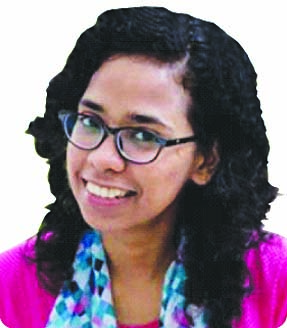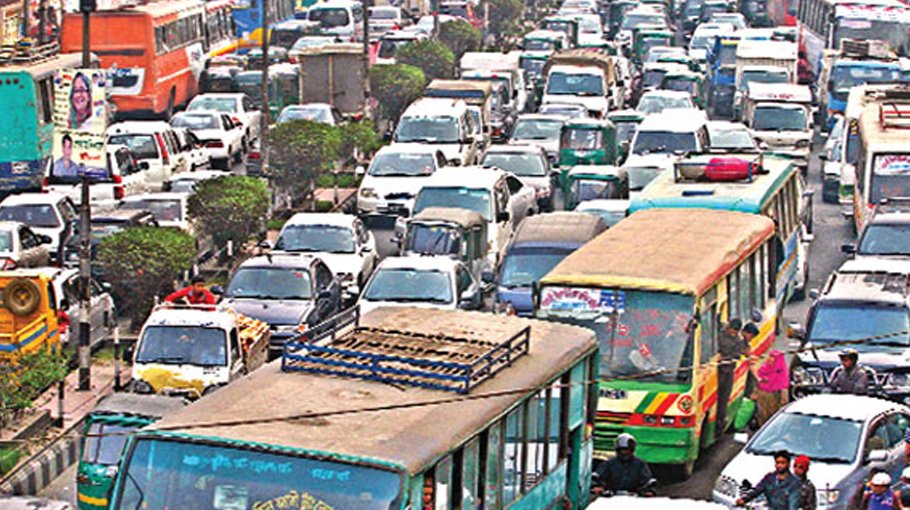Unplanned expansion of Dhaka increasing traffic jam

Many initiatives have been taken over the years to reduce the rapidly increasing traffic jam of Dhaka city.
However, unplanned burgeoning of the capital, an increase in the number of vehicles, population growth, lack of coordination among implementing agencies and many other reasons have compounded the situation and led to severe traffic congestion, opine experts.
According to a World Bank report of 2017, traffic congestion in Dhaka eats up about 3.2 million work hours every day and the average speed of vehicles during rush hours drop to about 7 kmph.
According to a recent study of Bangladesh Institute of Development Studies (BIDS), the frequent traffic jams caused by the unplanned expansion of the city eat up as much as 2.9 percent of the gross domestic production (GDP).
Talking to Bangladesh Post, Dr Md Shamsul Hoque, noted transport expert and Professor at the Department of Civil Engineering of BUET said that in order to make Dhaka congestion-free well-documented plans were made in 1994 and these plans were updated in phases in 1997, 2005, 2010 and 2015.
“Some of these initiatives have been implemented but in an undisciplined and unorganized manner. The tendency to develop without considering facts, rather than following the pyramid organizational structure has led to the increasing traffic congestion in this compact city,” he said.
He went on to describe, “It was suggested in the plans to develop an eco-system with public or mass transit system as the backbone. With ordinary bus at the bottom, bus routes could be disciplined through franchise system. Dedicated lanes for buses would provide a jam immune corridor and thus one bus could provide many trips every day. If users of small cars start riding the buses through modal shift, as these buses would run on a dedicated corridor and therefore make it possible for passengers to reach their destination faster, traffic jams could be reduced to a large extent.”
He emphasized prioritizing and adopting low-cost but cost-effective measures.
“40 percent of the congestion can be reduced just by introducing bus route franchising, disciplining the signal by bringing it under operation and making the footpaths pedestrian-friendly through eviction of illegal occupations,” he said.
The Accident Research Institute (ARI) of Bangladesh University of Engineering and Technology (BUET) and the Traffic Division of the Dhaka Metropolitan Police (DMP) will begin a traffic survey within the next few months to find out the root cause of traffic jams and improve the traffic management system.
Technical and financial proposal for this survey will be formulated by ARI and handed over to DMP.
Prof Dr Md Hadiuzzaman, Director, ARI of BUET told the Bangladesh Post, “The survey is being done in the context of the 111 recommendation of NRSC. Three of the 111 recommendations of NRSC are to find out the capacity of road infrastructure in the capital, number of vehicles currently plying on the roads of Dhaka and the number of vehicles that should be plying on the roads of Dhaka. DMP and ARI will jointly conduct a survey with these objectives in mind.”
Regarding the procedure of the survey the ARI director said, “Traffic sampling of Dhaka is very critical and time consuming as the traffic composition of the city is heterogeneous (not dominated by any specific vehicle). We will conduct a cordon survey to identify four types of traffic that include intra-zonal, internal-external, external-internal and through traffic to find out the number of vehicles that should be plying in Dhaka. In the next stage we will collect the Geographic Information System (GIS) map from RAJUK to find out the capacity of roads.”
Read more: Four more deaths on traffic-jammed Everest
Discussions regarding conducting this survey began in around April this year. The initiative is still at the proposal preparation stage.
Projects of constructing flyovers and U-loops were adopted to ease the gridlocks of the capital.
Seven flyover of Dhaka were built at a cost of over Tk 4000 crore while the ten U-loops were built at a cost of Tk 31 crore.
According to experts many of these were proven to be less effective in curbing traffic jam.
Talking to this correspondent, eminent urban planner Prof Nazrul Islam said, “The U-loops are effective but not much. The feasibility and technical issues should be discussed and reviewed by experts of BUET before moving forward with this type of projects as they are expensive and carry long-term impacts.”
However, he mentioned that most of the flyovers of Dhaka have reduced traffic congestion in the city to a great extent.
He said that although Mohakhali and Kuril flyovers have eased traffic jam, the Mogbazar-Malibag flyover was not well planned and therefore could not bring any effective results, rather increased traffic congestion.
According to DNCC officials, the target of the project was to reduce traffic congestion from 25 to 30 percent which has been achieved.



